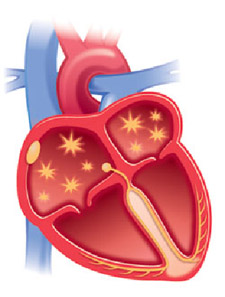An Overview of Heart Diseases and Disorders Part I of II
At some point in their lives, millions of people experience irregular heartbeats, called arrhythmias. They are harmless most of the time and occur in healthy people free of heart disease. However, there are some abnormal heart rhythms that can be serious or even deadly. Further, having other types of heart disease can also increase the chances of having an arrhythmia.
Disease Categories
Heart disease can be separated into three categories: Electrical, circulatory and structural abnormalities.
Electrical: Abnormal heart rhythms (arrhythmias) are due to problems with the electrical system that regulates the heart to beat steadily. The heart rate may be too fast or too slow; it may remain steady or become chaotic (disorganized and irregular). Some arrhythmias are very dangerous and can cause sudden cardiac death, while others may be benign though bothersome but not life threatening.
Circulatory: Coronary artery disease (blockage in the arteries of the heart) and high blood pressure are the main causes of blood vessel disorders. The results, such as heart attack and stroke, can be devastating. Fortunately, there are many types of treatment options available.
Structural: Congenital abnormalities (problems present from birth) and heart muscle disease (cardiomyopathy) are two problems that can damage the heart muscle or valves.
Electrical Disorders
Arrhythmias that start in the atria, the heart’s upper chambers include:
- Atrial Fibrillation (AFib or AF)
Over 2 million people in the U.S. and 200,000 people in Canada have atrial fibrillation. In AFib, the heartbeat is rapid and irregular due to disorganized signals from the heart’s electrical system. The atria, the upper chamber of the heart may beat as fast as 300 times per minute, about four times faster than normal.
Though AFib is not life threatening, it can lead to other rhythm problems, always feeling tired, and heart failure (with symptoms like, swelling in legs, feet and in hands, filling up with fluid and shortness of breath). People diagnosed with AFib are five times more likely to have a stroke. For this reason doctors often prescribe blood thinners (anticoagulants) to patients with AFib to reduce the high risk of stroke.
Infrequent AFib or asymptomatic Afib can be easily detected by a loop recorder with AFib autotriggers. When the cardiac event monitor detects an irregular rhythm it automatically records the rhythm to be reviewed by a Cardiologist. For persistent AFib a Holter monitor is an ideal choice to confirm the heart rate is well controlled.
- Atrial Flutter
Atrial flutter is like AFib in that it also causes a fast beat in the atrium. However, unlike Afib, AFL is caused by a single electrical wave that circulates very rapidly in the atrium, sometimes around 300 times a minute. This leads to a very fast heartbeat.
- Sick Sinus Syndrome
Sick sinus syndrome is not a disease per se, but a group of symptoms or signs that show the heart’s natural electrical pacemaker, the sinus node, isn’t working properly. In SSS, the heart rate can switch between fast (tachycardia) and slow (bradycardia). Treatment for SSS is usually medication along with an artificial pacemaker.
- Sinus Tachycardia
Sinus tachycardia is a normal increase in heart rate that happens with excitement, exercise and fever. There is no need for treatment, except when it is caused by an underlying problem, such as hyperthyroidism (overactive thyroid gland) or anemia (low blood count).


